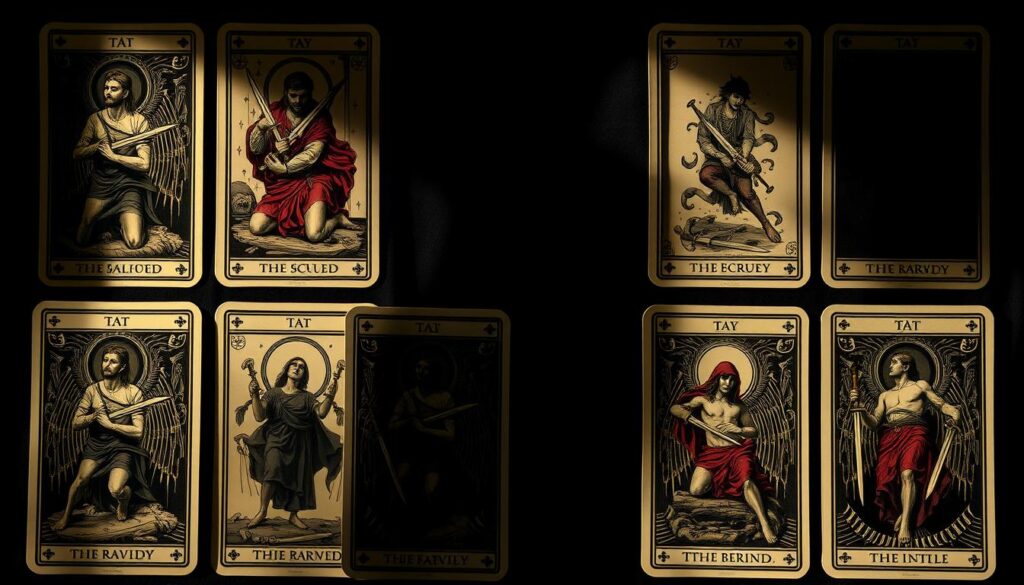Ever feel stuck in your own thoughts? The Eight of Swords card in tarot speaks directly to this struggle. It shows a blindfolded woman surrounded by swords—symbolizing mental traps we create for ourselves. Though she could walk free, fear and doubt keep her in place.
This powerful imagery mirrors modern life. We often limit ourselves with negative beliefs about love, careers, or money. The good news? The card reminds us that freedom is possible once we recognize these invisible chains.
DK Books’ tarot guide suggests this card invites deep self-reflection. Whether you’re new to tarot or a seasoned reader, understanding its message can help shift your perspective. Let’s explore how to break free from self-imposed barriers and reclaim control.
Key Takeaways
- The Eight of Swords highlights mental blocks, not physical limitations.
- Self-doubt often creates false barriers in love, work, and finances.
- Recognizing these patterns is the first step toward change.
- Tarot serves as a tool for honest self-reflection.
- Freedom comes from challenging limiting beliefs.
The Eight of Swords: Symbolism and Core Message
Mental barriers often feel more real than physical ones. This tarot card shows a blindfolded woman standing amid eight upright blades. Though the swords don’t form a complete cage, her posture suggests passivity—a stark reminder of how we trap ourselves.

Imagine this scene: gray skies, cracked earth, and no visible threats—a mirror for emotional stagnation. The blindfold symbolizes self-deception, while the swords represent mental blocks. As one interpretation notes:
“She could escape by removing the blindfold.”
Here’s what makes this imagery profound:
- Space to move: The swords aren’t touching her. Like many limitations, they’re perceptual.
- Barren landscape: Reflects creative or spiritual dryness—common in career ruts or relationship stalemates.
- Victim mentality: The figure’s bound hands imply surrender, though no ropes exist.
Modern life amplifies these themes. We fixate on fear of failure or judgment, ignoring the open paths around us. Developing clairvoyance—clear self-awareness—helps dissolve these illusions.
Ultimately, the card’s message is hopeful: traps are self-created and escapable. Recognizing that is the first step toward liberation.
Upright vs. Reversed: Key Meanings of the Eight of Swords
Self-doubt can be a silent prison—have you noticed its bars? The card’s orientation changes its message dramatically. Upright, it screams stagnation. Reversed, it whispers possibility.

Upright Interpretation: Feeling Trapped and Powerless
Upright, this card reflects mental paralysis. You might feel stuck in a job, a relationship, or financial anxiety. The swords aren’t physical—they’re your own limiting beliefs.
Examples:
- Love: Staying in unfulfilling relationships due to fear of loneliness.
- Career: Clinging to a stable but soul-crushing role (*golden handcuffs*).
- Finances: Avoiding investments because “money is scarce.”
Reversed Interpretation: Finding Freedom and Empowerment
Reversed, the mental chains loosen. You start seeing options. A study on PTSD recovery notes this position mirrors overcoming depressive cycles.
Contrasts with upright:
| Upright | Reversed |
|---|---|
| Fear-driven choices | Action from clarity |
| Scarcity mindset | Creative solutions |
| Victim mentality | Ownership of power |
Contextual Insights: Love, Career, and Finances
Love: Upright reveals toxic patterns. Reversed? Setting boundaries or leaving dead-end partners.
Career: Upright warns of complacency. Reversed encourages entrepreneurship—like turning hobbies into income.
Finances: Upright magnifies money fears. Reversed inspires budgeting apps or side hustles.
How the Eight of Swords Reveals Self-Imposed Limitations
What if your biggest obstacles exist only in your mind? This tarot card exposes how we trap ourselves with false narratives. The blindfold isn’t tied by others—we put it there.
Three mental traps keep us stuck:
- Catastrophizing: “One mistake will ruin everything”
- Learned helplessness: “I’ve always failed, so why try?”
- Confirmation bias: Only noticing evidence that supports our fears

Neuroscience shows chronic stress shrinks the prefrontal cortex. This reduces problem-solving skills by 30%. When overwhelmed, the brain sees fewer options—creating the illusion of no escape.
Career myths crumble under scrutiny. That “dead-end job”? Transferable skills exist. The “risky” business idea? Start small. As DK Books notes:
“Self-made traps require self-driven escapes.”
Brené Brown’s research reveals perfectionism stems from fear of judgment. Vulnerability—not control—breaks this cycle. Comfort zones become straitjackets when we mistake familiarity for safety.
| Limiting Mindset | Liberating Alternative |
|---|---|
| “I’m powerless in this situation“ | “I choose where to focus my power“ |
| “This is just my reality“ | “Thoughts shape experience—I can shift mine” |
| “Failure means I’m not enough” | “Growth requires imperfect steps” |
The swords represent thoughts we can rearrange. Cognitive restructuring helps: identify a limiting belief, challenge its truth, then replace it. No external savior needed—just willingness to remove the blindfold.
What’s holding back isn’t the swords around you, but the story you’ve glued to them. Change the narrative, and the cage disappears.
Practical Steps to Break Free from the Eight of Swords Mindset
Breaking free starts with recognizing the invisible walls you’ve built. The good news? Simple strategies can help shift your perspective and create real change. Let’s explore actionable ways to move from stagnation to liberation.

Removing the Blindfold: Shifting Perspective
Your mindset shapes your reality. Try these techniques to see new options:
- Fear-setting: Tim Ferriss’ method asks: “What’s the worst that could happen?” Often, the imagined disaster is unlikely.
- Gratitude tracking: Note three daily wins. This counters negativity bias.
- Thought replacement: Swap “I’m trapped” with “I’m exploring possibilities.”
One freelancer used these tools to leave corporate work. She realized her “stable job” actually had less security than her side hustle’s potential.
Taking Action: Small Moves Toward Liberation
Progress happens through micro-steps:
- 30-day challenges (e.g., send one networking email daily)
- Monetize skills gradually (like reading tarot at cafes)
- Creative financial solutions (bartering, skill swaps)
“Action dissolves anxiety. Movement creates momentum.”
Seeking Support: When to Ask for Help
Sometimes the clearest way forward requires guidance. Consider reaching out when:
- Financial patterns repeat (a planner can reveal blind spots)
- Anxiety feels overwhelming (therapists provide tools)
- Career transitions stall (coaches offer accountability)
Remember: Asking for support isn’t weakness—it’s strategic. Our free Mental Escape Kit (with vision board templates) can help start your journey.
Conclusion: Embracing Your Power Beyond the Eight of Swords
True power lies in recognizing your mental chains. Passivity keeps you stuck, but small actions break the cycle.
Flip fear into clarity. Try one “blindfold removal” step weekly—like updating your money mindset or saying no to doubt.
Tools like the Tarot Guide app help track progress. Revisit DK Books’ insights to keep growing.
Your barriers are illusions. Step forward—freedom is closer than you think.

